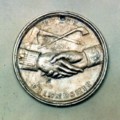| When the peoples of two so very distinct cultures collide, as they did on the Uyayp (Weippe) prairie during the time of Q'emes (camas) digging, misconceptions and misrepresentations are likely to follow.
For the Nimíipuu, they would ask who were these strange creatures, foul of smell, with blue eyes, many with upside down heads (bald on top with hairy beards below), and one whose skin color was as dark as night? While the prophecies had long told of the coming of the soyaapo (white men), would they simply pass through or stay, and, if they settled, would they bring strife or benefit to the Nimíipuu? Already there was great and substantiated misgivings with the winds of change, with so many children and elders dying of unknown illnesses, yet powerful rifles and other metal tools already found their way among the Nimíipuu. When these strangers first appeared, the Nimíipuu already had traded for and acquired rifles, and were most appreciative of the gun powder and lead balls given by Lewis and Clark. Future trading benefits could be initiated. But it was only in the words of the old woman, Wetxuwiss, that the strangers were saved.
| |
Listen, as Allen Pinkham discusses some of the misconceptions concerning the Corps of Discovery's experience with the Nimíipuu. In this clip, on knowing of the coming of Lewis and Clark long before their arrival. (Interviewed by Josiah Pinkham in November 2001) |
For the Corps of Discovery, their mission was a commercial, scientific and military expedition. Due to the nature of their mission and their cultural background, Lewis and Clark viewed the landscape, or wilderness, as something to be conquered, tamed, or put to use. Thus, their conception of the landscape was primarily seen through political, scientific and economical eyes. These military-trained men were to locate and chart a direct water route across America in order "to extend the external commerce" of the United State. Knowledge of the Indian inhabitants was to be obtained to secure a peace and initiate commerce with them. With their keen eyes for scientific observation, Lewis and Clark were to identify and collect samples of the many plant and animal species they come across, and to chart the natural geography and geology of the land. And in their discovery, maps were to be drawn, and names were to be given to the places and routes through the landscape. The expedition's writings about the Clearwater Valley described the landscape in terms of measurements, physical characteristics, and resources available. However, this does not imply that the expedition lacked respect for the landscape or failed to appreciate the beauty that surrounded them. The land of the Chop pun-nish would be only one of many Indian lands identified and mapped and named and commercially secured for the westwardly expanding United States.
| |
Listen, as Allen Pinkham discusses a misrepresentation of the "madness" in a woman's actions. (Interviewed by Josiah Pinkham in November 2001) |
In the process, the men of the Corps of Discovery would call the Nimíipuu women "Squar", (squaws) and some of their band headmen, "chiefs". The imposition of the political office "chief" by the missionaries would be later used to help control people. Both these terms would misrepresent and lead to anguish. The actions of redistributing the food would be called a theft, as the "young Indians Stole Some of our fish and went away in the night. . . . ." (See Ordway journal entry May 31st in the side bar and Allen Pinkham's interview below.)
Would these strangers, as they passed in the canoes that the Nimíipuu helped them fashion, see Coyote's Fishnet or the Ant and Yellowjack in the hillsides of the Clearwater? Would they know of the Animal Peoples who formed and gave life to this land? Would these strangers follow the cycles of the seasons, moving with the salmon runs and the camas blooms? Would these strangers understand the ethic of sharing and the role the salmon headmen in overseeing that no one in the community went hungry? And would these strangers seek their guidance by fasting on the high mountain ridges? Would these strangers see themselves as an integral and inseparable part of the landscape itself, and view the surrounding topography as being spiritually endowed, a sacredness embodied in all things? Would Lewis and Clark appreciate that generations upon generations, since time immemorial, have resided in this same location, developing a strong sense of place. Or would this landscape and its many peoples mean something all together different to Lewis and Clark and those who would follow?
| |
Allen Pinkham discusses John Ordway's experience with salmon and his misinterpretation of a "Cho pun-nish theft." (Interviewed by Josiah Pinkham in November 2001) |
© Nez Perce Tribe 2002
< previous |
next >
|








